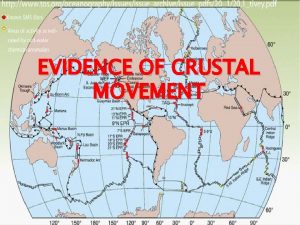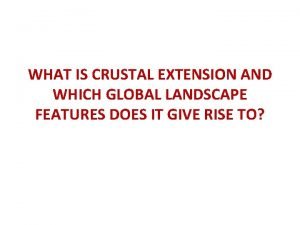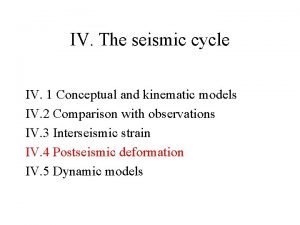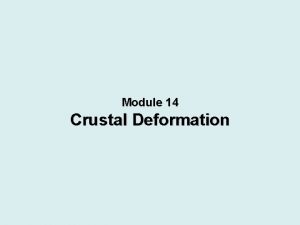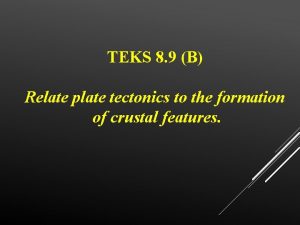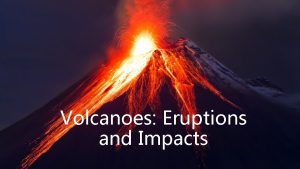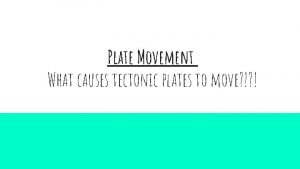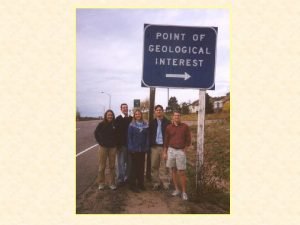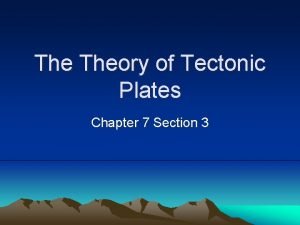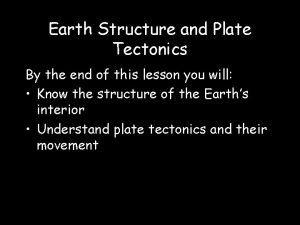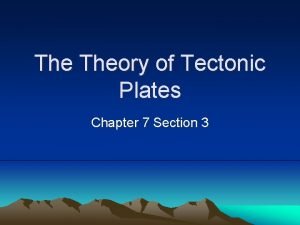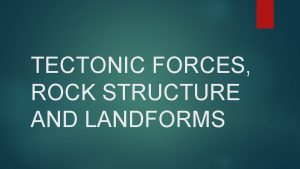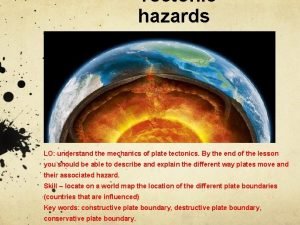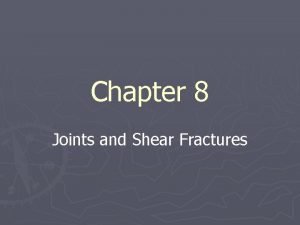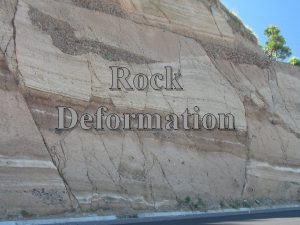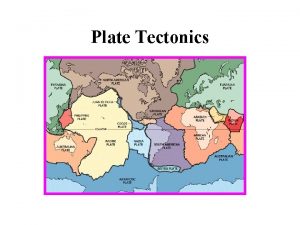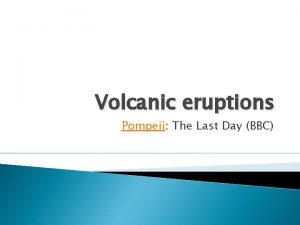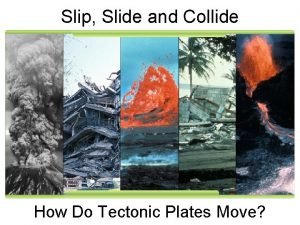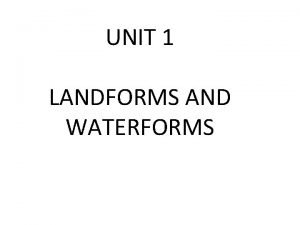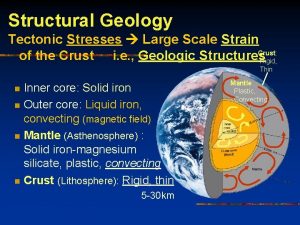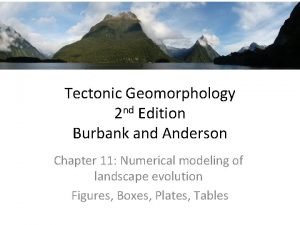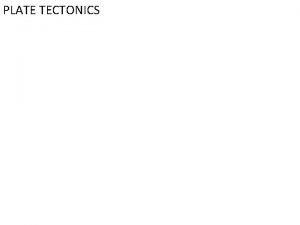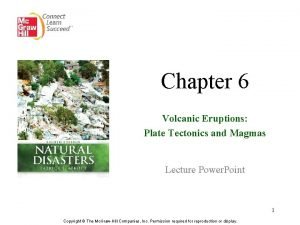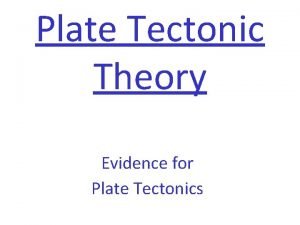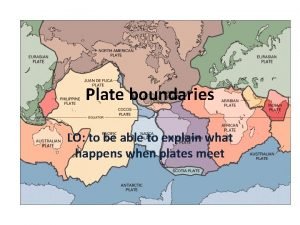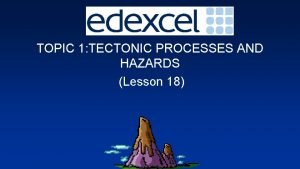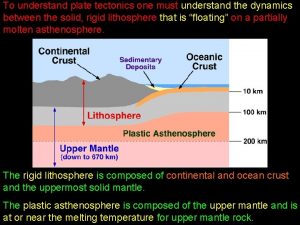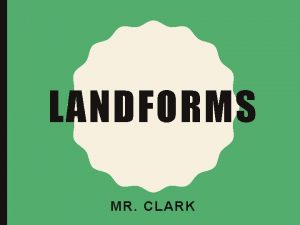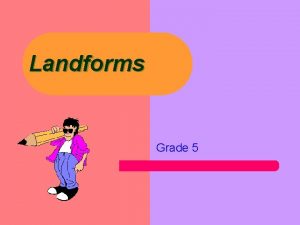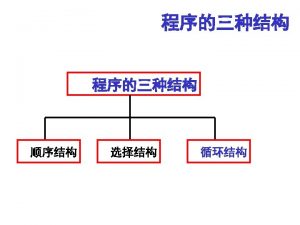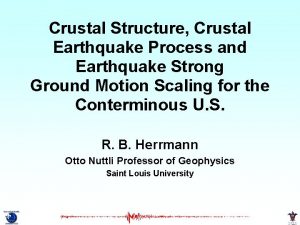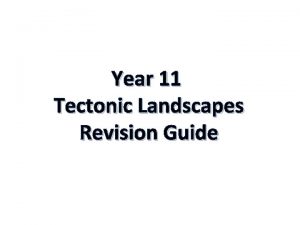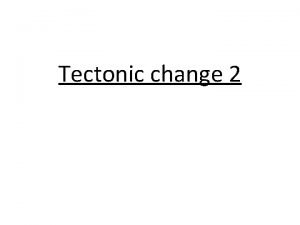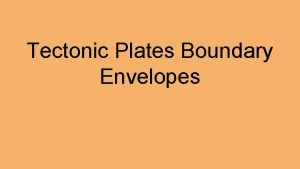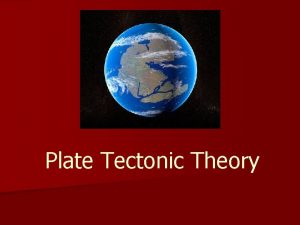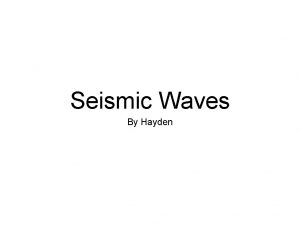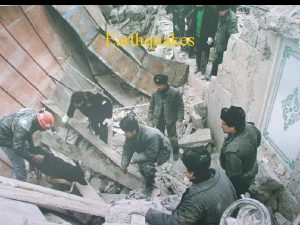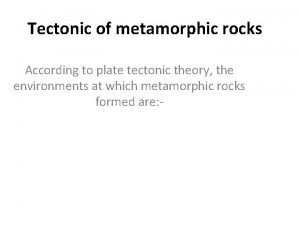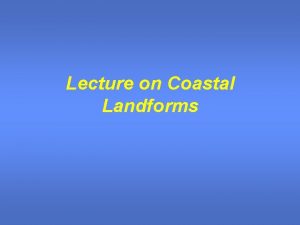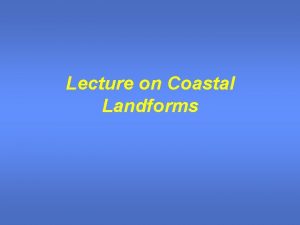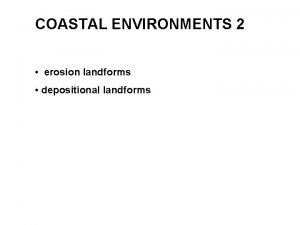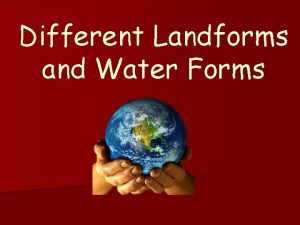Lecture 5 Tectonic Landforms that result from crustal
















































- Slides: 48

Lecture 5 Tectonic Landforms that result from crustal movements Landforms with little erosion so "their shape defines a fractured or deformed surface" Bloom

Escarpment or "scarp" • Tectonic Scarp: steep slope from differential movement of surface Basaltic Lava Flows Axial Lake Deposits Soils FW HW High angle Normal faults, Tanzania Rift Valley http: //travel. mongabay. com/tanzania/images/tz_elf_0560. html Border Fanglomerate

Flatirons • Dissection of scarp ( often a side of a hogback) by many gullies forms triangular facets http: //en. wikipedia. org/ wiki/File: Flatirons. jpg

Joints: Fractures – with no movement http: //www. pbase. com/dougsherman/image/93468807

And on Mars … Link courtesy Melissa Hansen

Faults 1: Normal Faults • Typical of Divergent Margins • Rift Valleys and Mid. Ocean Ridges • High-angle and Listric • Horst and Graben Structure • Hanging wall is down

Divergent Margins @ MOR, Iceland

Graben in Iceland, a subaerially exposed Mid. Ocean Ridge Source: Simon Fraser/Science Photo Library/Photo Researchers, Inc.

Rift Valley x-sec Origin of Basaltic magma 2

Faults 2: Reverse Fault Structures • Typical of Convergent Margins • E. g. Accretionary Wedges (Santa Catalina Island’s schists) and Fold and Thrust Mountains (Himalayas, Alps, Appalachians) • Often low-angle thrusts • Hanging wall is up Overhanging Block http: //rst. gsfc. nasa. gov/Sect 2/05 -01_reverse_fault-jyougashima_DSC 8766. jpg

http: //www. flickr. com/photos/mirkazemian/356833099/sizes/o/ Reverse Fault Scarp

Klippe - Thrust Fault Remnant A feature of thrust fault terranes. The klippe is the remnant portion of a nappe after erosion. http: //www. pbase. com/dougsherman/image/93469147 Chief Mountain, a klippe outlier of the Lewis Thrust, Glacier National Park, MT

Faults 3: Transform Faults between MOR's

Strike-slip fault http: //epod. usra. edu/archive/images/wallace_creek_aerial. jpg

Sag pond along San Andreas Transform (strike-slip) Fault


The linear strike-slip feature running across this anaglyph is one of many transform faults in California. Along it can be seen good examples of off-set streams [and] a shutter ridge. From Drury, text paraphrased.

Structural Control by Folds Overturned folds in the Paleozoic rocks of the Marathon Basin of Texas. The ridges are controlled by resistant carbonates. From Drury, Ch. 4

A Monocline near Cody, Wyoming

Upwarps 1: The Adirondack Mountains of Northern New York Source: Clyde H. Smith/Allstock/Tony Stone Images Although the rocks are ancient, the uplift that formed the Adirondack dome has occurred within the last 5 million years — relatively recent in geologic time — and is ongoing. Mantle upwelling, Upwarp Mountains

Upheaval Dome, Canyonlands Colorado Plateau Uplift http: //www. pbase. com/dougsherman/image/93400984

Salt Dome Low density Buoyant Salt Diapirs Surrounding sediments upwarped Petroleum exploration

A collapse downwarp Salt Creek Graben at Arches National Park, UT. Solution of evaporites in the underlying Pennsylvanian Paradox Fm. caused the Graben to form.

Plumes under Continent Interiors. A Rhyolitic Igneous Dome, Yellowstone Caldera

Mars: frost heave? A 2005 photo of Elysium Planitia by the Mars Express spacecraft shows what may be ash-covered water ice. The volume of ice is estimated to be 800 by 900 kilometers in size and 45 meters deep, similar in size and depth to the North Sea. Mounds S. of Elysium Planitia a few kilometers in diameter about 60 meters tall. Fractures suggest mounds formed by uplift Uplift is not uniform mounds are probably solidified lava. Mounds contiguous with and texturally similar to flood lavas over Elysium Planitia. Where dilation cracks provide crosssectional exposure, the uplifted material is rocky. Link courtesy Melissa Hansen Frost heave on a huge scale?

Review of Cenozoic Tectonics http: //www. globalchange. umich. edu/Ben/Helvetic%20 Morcles%20 nappe. JPG A nappe is a large sheetlike body of rock that has been moved more than 2 km (1. 2 miles) from its original position. Nappes form during continental plate collisions, when folds are sheared so much that they fold back over on themselves and break apart. The resulting structure is a large-scale recumbent fold. The term stems from the French word for tablecloth.

• Cenozoic Orogenic activity concentrated in two areas – Alpine-Himalayan belt deformation began in the Mesozoic and remains geologically active. Isolation of Tethys to form the modern Mediterranean Sea – circum-Pacific belt deformation occurred throughout the Cenozoic

1. The underside of Europe collided with numerous microplates rifted from Africa Closing of the Tethys Sea between late Mesozoic and early Cenozoic time 3. Messinian Salinity Crisis ~ 5. 5 mya 4. Thrusts not Subduction Arabian-African Rift 2. Pliocene three way rift. 3. Arabia Microcontinent collision -> Zagros Mts

Subduction-Zone Features Note sequence from land to trench Note ocean plate rocks that don’t get subducted in a collision If a continent converges from the left, what rocks will fold in the collision? Himalayas

Continent Back-Arc Basin Trench Accretionary wedge Fore-Arc Basin Volcanic Arc • Abyssal plains – Can be sites of thick accumulations of sediment – Sediments thickest away from MOR – Abyssal plains found in all oceans – Studded by old cold seamounts and MORs

Drawings of Nappes in the Alps New Orogen, Nappes still visible http: //www. geol-alp. com/chartreuse/3_tecto_chartreuse/1_ch_occ. html

"A spectacular thrust fault in the Caledonides of NW Scotland, which drove Archaean gneisses over Cambro-Ordovician sediments. The thrust plane is marked by the pronounced bench on the peninsula, which is coated with mylonite. The typical knobbly topography of the heavily glaciated gneisses is quite obvious in the upper part …. " From Drury, Ch. 4 Definition Nappes previous slide

Himalayan Orogeny Subduction and TST Partly subducted so under AW

Himalayan Orogeny AW FAB

INDIA under cloud cover Rain Shadow Desert: Tibetan Plateau Fold and Thrust Mountains, Himalayas, Continent-Continent collision North

Taklamakan Desert NORTH Tibetan Plateau Hi ma lay as

San Andreas Transform MOR Subducted! Changed Orientation 15 mya SAF forms

North American Cordillera Topography WHY SO FAR INLAND? Basin and Range Crust very thin there Columbia River Basalts

Tertiary Tectonic Events K-T Laramide Continental Override Buoyant Subduction

North American Cordillera

Rockies: Buoyant Subduction caused Laramide Orogeny Vertical block uplift Normal, thin-skinned Approaching Continent pushes accretionary wedge sediments into forearc sediments

The Grand Tetons in Wyoming Source: Peter French/DRK Photo High Angle Faults, Buoyant Subduction.

Later origin of Fault Block Mountains “Basin and Range” Southwestern North America But why so Wide? Breakup of flat buoyantly subducted Farallon Plate? Huge divergent zone, Basin and Range, not so far inland as Rockies, more normal subduction dip resumes, partial melting in mantle, magma rises similar to rift valley.

Basin and Range province Range Extensional Feature w/ Normal Faults Basin

Rift vs. Basin and Range Mirror symmetry, radial cracks about center, divergence, normal faults Conjugate shear fractures, divergence, normal faults

Displaced terranes – Western Cordillera These terranes overlap in age but have different rock types, paleolatitudes and fossils. However, we can deduce when they accreted from their order, and the metamorphic ages of their suture zones

Columbia River Basalts (including the Saddle Mountains Basalt) 17 my

Columbia River Basalts and Yellowstone Plume http: //en. wikipedia. org/wiki/Columbia_River_Basalt_Group
 Crustal movement examples
Crustal movement examples Crustal deformation
Crustal deformation Crustal extension
Crustal extension Crustal deformation
Crustal deformation Earths major crustal plates
Earths major crustal plates Crustal deformation
Crustal deformation Gây tê cơ vuông thắt lưng
Gây tê cơ vuông thắt lưng Premature atrial contraction
Premature atrial contraction Sau thất bại ở hồ điển triệt
Sau thất bại ở hồ điển triệt Tìm vết của đường thẳng
Tìm vết của đường thẳng Thể thơ truyền thống
Thể thơ truyền thống Con hãy đưa tay khi thấy người vấp ngã
Con hãy đưa tay khi thấy người vấp ngã Thơ thất ngôn tứ tuyệt đường luật
Thơ thất ngôn tứ tuyệt đường luật Tôn thất thuyết là ai
Tôn thất thuyết là ai Ngoại tâm thu thất chùm đôi
Ngoại tâm thu thất chùm đôi Walmart thất bại ở nhật
Walmart thất bại ở nhật 01:640:244 lecture notes - lecture 15: plat, idah, farad
01:640:244 lecture notes - lecture 15: plat, idah, farad Plate tectonic gizmo answers
Plate tectonic gizmo answers What tectonic plate is south africa part of
What tectonic plate is south africa part of Convergent divergent
Convergent divergent Shield volcano
Shield volcano Tectonic movement
Tectonic movement Mount fuji plate boundary
Mount fuji plate boundary 7 tectonic plates
7 tectonic plates Tectonic
Tectonic What causes tectonic plates to move? *
What causes tectonic plates to move? * Tectonic
Tectonic Tectonic plates move
Tectonic plates move East pacific rise
East pacific rise Joints geology
Joints geology Plunging anticline
Plunging anticline Primary and secondary effects of a tectonic hazard
Primary and secondary effects of a tectonic hazard Egg tectonic plates
Egg tectonic plates Pompeii tectonic plates
Pompeii tectonic plates Playe tectonics
Playe tectonics Slip slide collide
Slip slide collide Convection cells
Convection cells What is the border between two tectonic plates called
What is the border between two tectonic plates called Plunging anticline
Plunging anticline Luther burbank middle school
Luther burbank middle school Oreo tectonics
Oreo tectonics A plate
A plate Tectonic plates quizizz
Tectonic plates quizizz Tectonic setting of stratovolcanoes
Tectonic setting of stratovolcanoes Plate tectonic theory evidence
Plate tectonic theory evidence Blank plate tectonics map worksheet
Blank plate tectonics map worksheet Tectonic hazard profile
Tectonic hazard profile Continent continent convergent
Continent continent convergent S waves
S waves
